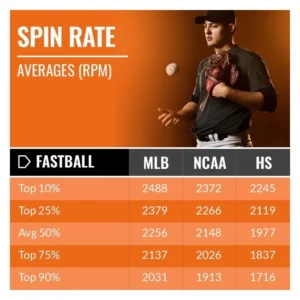 In the ever-evolving sport of baseball, the pursuit of mastering the perfect pitch has increasingly centered on understanding and optimizing Pitch Grips & Fastball Spin Rate. To improve pitcher performance and outsmart batters at the plate, this intense focus is necessary. The article delves into the complex interplay between grip strength and spin rate, which has become a significant area of study, especially for adolescent pitchers.
In the ever-evolving sport of baseball, the pursuit of mastering the perfect pitch has increasingly centered on understanding and optimizing Pitch Grips & Fastball Spin Rate. To improve pitcher performance and outsmart batters at the plate, this intense focus is necessary. The article delves into the complex interplay between grip strength and spin rate, which has become a significant area of study, especially for adolescent pitchers.
The relevance of this topic has been amplified following the 2021 ban on the use of foreign substances by pitchers. These substances, like pine tar and spider tack, were once commonly used to improve grip and, consequently, increase the spin rate of pitches. Their prohibition has compelled pitchers and coaches to seek legal ways to achieve similar benefits, leading to a renewed interest in how physical attributes such as grip strength could naturally influence a pitch's spin rate.
As young athletes develop, understanding how their physical capabilities impact their pitching mechanics becomes crucial. This exploration into grip strength and spin rate is not only about enhancing performance but also about ensuring young pitchers develop their skills in a way that promotes long-term arm health and effectiveness on the mound. The shift away from artificial enhancers like foreign substances represents a move toward more sustainable and fair pitching practices, emphasizing natural skill and athletic development.
Understanding Spin Rate and Its Importance: Pitch Grips & Fastball Spin Rate
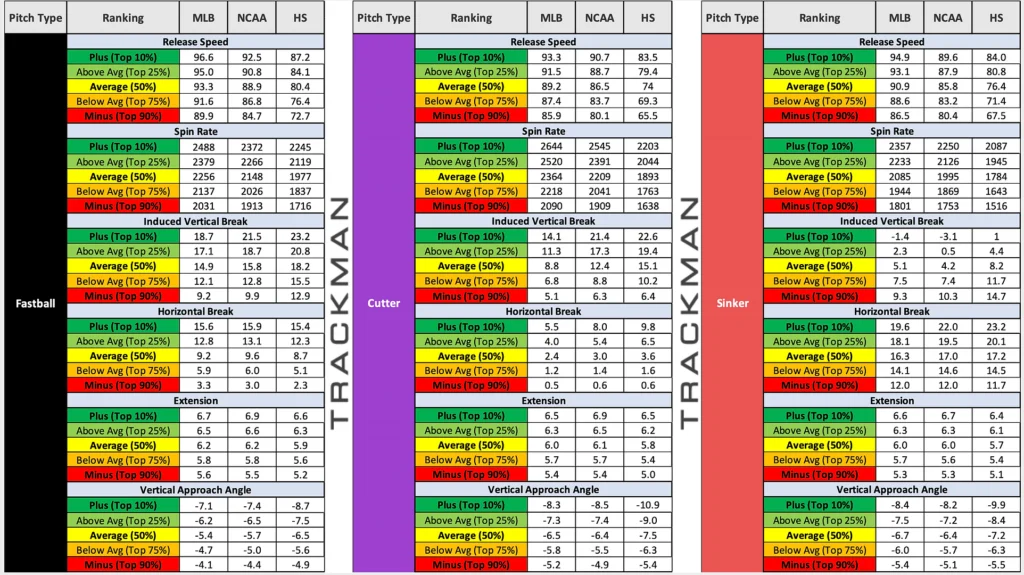
Understanding spin rate is essential for grasping the finer mechanics of pitching in baseball. Spin rate is quantified in revolutions per minute (rpm), and it plays a pivotal role in determining the trajectory and behavior of a baseball once it leaves a pitcher's hand. Typically, a professional pitcher's fastball has a spin rate of around 2200 rpm. This rate of spin directly impacts the Magnus effect, which is the phenomenon that causes the ball to move through the air in a curved path due to its spin.
The Magnus effect influences whether the baseball experiences lift or drop during its flight. This effect can significantly deceive hitters, as it alters the expected path of the ball, making it challenging to track and hit accurately. For pitchers, mastering spin can be a key strategy in dominating the game, as the spin dictates whether the pitch will rise, fall, or veer off to the side, adding an element of unpredictability that can be used to their advantage.
The importance of spin rate extends beyond just the mechanics of pitching; it has a profound impact on gameplay strategy and outcomes. Higher spin rates can dramatically change how a pitch moves. For example, fastballs that spin at rates higher than the average can generate more lift. This additional lift means that the ball stays in the air longer and drops less as it nears the plate, which can counteract the gravitational pull that typically causes a pitch to sink. Consequently, these pitches are harder for batters to hit effectively, leading to higher strikeout rates and fewer hits off fastballs.
In essence, a pitcher with the ability to throw a high-spin fastball has a tactical advantage, as this can lead to increased effectiveness in fooling batters and securing strikeouts. As such, understanding and optimizing spin rate is not just about throwing the ball; it's about crafting pitches that enhance a pitcher's control over the game, making it an indispensable skill in the competitive sport of baseball.
The Grip and Spin Correlation: Pitch Grips & Fastball Spin Rate
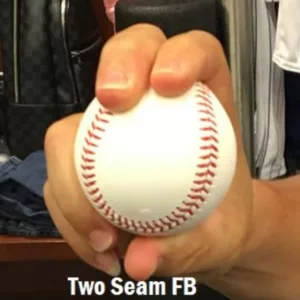 The correlation between grip strength and spin rate has become a focal point in baseball, particularly after the 2021 ban on foreign substances. This ban prompted pitchers and coaches to explore legal alternatives for enhancing pitch effectiveness, leading to a renewed interest in physiological factors like grip strength that could naturally influence spin rates.
The correlation between grip strength and spin rate has become a focal point in baseball, particularly after the 2021 ban on foreign substances. This ban prompted pitchers and coaches to explore legal alternatives for enhancing pitch effectiveness, leading to a renewed interest in physiological factors like grip strength that could naturally influence spin rates.
Understanding the Role of Pitch Grips & Fastball Spin Rate
Grip strength, the force a pitcher can exert through their hand, is intuitively linked to how tightly a player can hold and release the baseball. Theoretically, a firmer grip could allow for more forceful and controlled manipulation of the ball at the point of release, potentially increasing the spin rate. Spin rate, as previously mentioned, is crucial for determining the trajectory and deception of pitches, influencing how challenging they are to hit.
Investigating the Grip Strength-Spin Rate Hypothesis
In response to the changing regulations, recent studies, including the detailed investigation by William Rouse at Malone University, have sought to empirically test the hypothesis that enhancing grip strength could lead to higher spin rates. Rouse's study, guided by Dr. Kylene Boka, was designed to explore this potential relationship by implementing a structured training program focused on improving the grip strength of young pitchers and observing any corresponding changes in their pitch spin rates.
The Complexity of the Grip Strength and Spin Rate Relationship
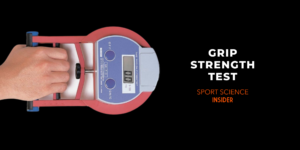 The findings from Rouse's study and similar research have suggested that the relationship between grip strength and spin rate is not as direct or significant as initially hypothesized. While it seems logical that stronger grip strength would enable a pitcher to impart more force on the ball, thereby increasing its spin, the actual influence of grip strength on spin rate appears to be nuanced and influenced by a variety of factors.
The findings from Rouse's study and similar research have suggested that the relationship between grip strength and spin rate is not as direct or significant as initially hypothesized. While it seems logical that stronger grip strength would enable a pitcher to impart more force on the ball, thereby increasing its spin, the actual influence of grip strength on spin rate appears to be nuanced and influenced by a variety of factors.
These factors include the individual pitcher's mechanics, the way they hold and release the ball, and their overall physical conditioning. For example, a pitcher's arm speed, wrist motion, and finger release timing play crucial roles in the spin and trajectory of the ball. Therefore, even though grip strength is a crucial tool in a pitcher's arsenal, these other contributing factors may limit its direct impact on spin rate.
In conclusion, the quest to enhance spin rates through increased grip strength continues to be an area ripe for further investigation. The preliminary findings indicate a complex interaction between physical strength and pitching mechanics, suggesting that a multifaceted approach, rather than focusing solely on grip strength, may be required to effectively increase spin rates and improve pitching performance.
Detailed Exploration of the Study: Pitch Grips & Fastball Spin Rate
Rouse, W. T. (2023). Correlation of Grip Strength and Spin Rate as it Relates to Fastball Pitches for Adolescent Athletes (Bachelor's thesis, Malone University).
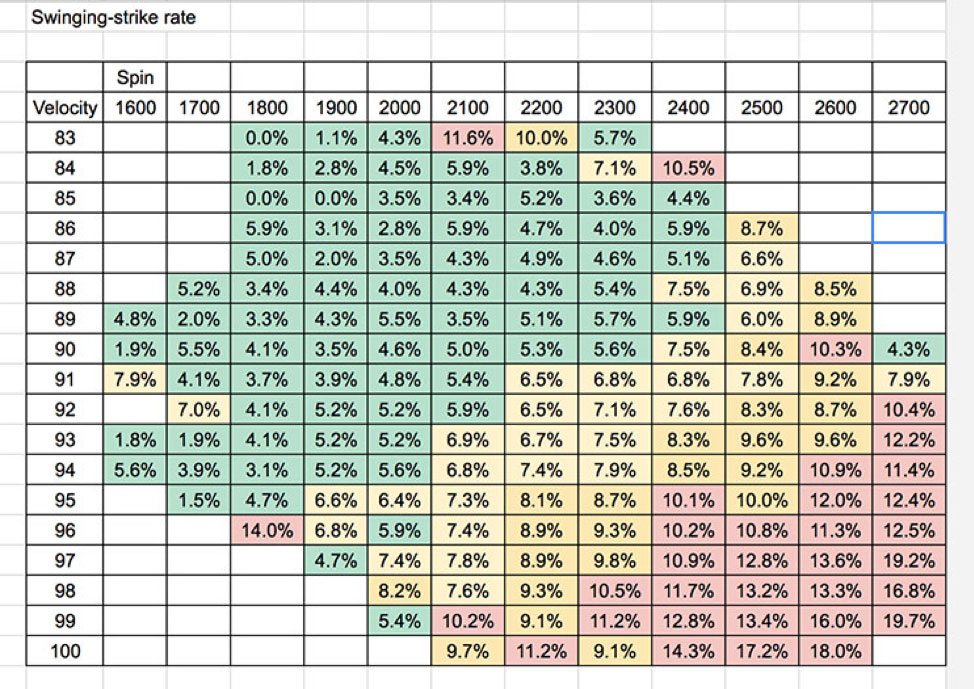
The Experiment Setup
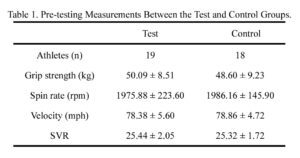 The study in question targeted high school-aged pitchers, a group at a developmental stage ideal for examining the effects of physical training on pitching performance. The experiment was designed around a structured training regimen aimed specifically at enhancing the grip strength of these young athletes. The hypothesis posited that by improving grip strength, the pitchers would be able to increase the spin rate of their fastballs—a key factor in effective pitching as it can dictate the pitch’s movement and its deception against batters.
The study in question targeted high school-aged pitchers, a group at a developmental stage ideal for examining the effects of physical training on pitching performance. The experiment was designed around a structured training regimen aimed specifically at enhancing the grip strength of these young athletes. The hypothesis posited that by improving grip strength, the pitchers would be able to increase the spin rate of their fastballs—a key factor in effective pitching as it can dictate the pitch’s movement and its deception against batters.
The training program was comprehensive, incorporating various exercises tailored to strengthen the muscles involved in gripping. These exercises were not only focused on the hand and forearm but also integrated full-arm and shoulder routines to support overall arm health and pitching mechanics. The expectation was that these targeted workouts would translate into tangible improvements in the pitchers' ability to grip and spin the baseball more effectively during games.
Conducting the Study
Participants were monitored over a specified period, during which their grip strength and spin rates were regularly measured. The initial assessments provided baseline data against which subsequent performance could be evaluated. The grip strength was measured using standard dynamometric tools that provided precise readings necessary for scientific accuracy. Spin rates were captured using high-speed cameras and tracking technology that recorded the ball's rotation post-release.
Results and Interpretations
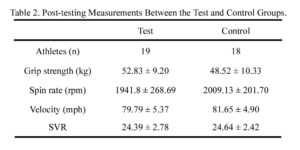 Upon completion of the training program, the collected data were analyzed to determine the relationship between the pitchers' improved grip strength and any changes in their spin rates. Contrary to the initial hypothesis, the results indicated no significant correlation between the increased grip strength and changes in spin rate. This outcome suggested that while the pitchers had developed stronger grips, this physical enhancement did not translate into the expected increase in spin rate.
Upon completion of the training program, the collected data were analyzed to determine the relationship between the pitchers' improved grip strength and any changes in their spin rates. Contrary to the initial hypothesis, the results indicated no significant correlation between the increased grip strength and changes in spin rate. This outcome suggested that while the pitchers had developed stronger grips, this physical enhancement did not translate into the expected increase in spin rate.
The findings led to a deeper analysis to understand why the anticipated correlation was not observed. It became apparent that spin rate might be more heavily influenced by other factors such as pitching mechanics, the natural variation in individual physical attributes, and perhaps even the psychological aspects of pitching under game conditions. For example, the timing of finger release, wrist snap, and overall delivery technique could have more substantial effects on the ball's spin than grip strength alone.
Concluding Insights
The study's results underscored the complexity of baseball pitching, revealing that enhancing a single physical attribute might not be sufficient to improve a specific aspect of pitching performance. This insight is crucial for coaches and trainers as it suggests the need for a holistic approach to pitcher development, focusing not just on strength but also on technique and other biomechanical factors. While the initial hypothesis was not supported, the experiment provided valuable data that could guide future research and training programs aimed at understanding and improving spin rate and overall pitching efficacy.
Broader Implications of the Study: Pitch Grips & Fastball Spin Rate
- Insights into Physical Conditioning: The findings from the study, while not confirming the direct impact of grip strength on spin rate, offer valuable insights into the complex dynamics of pitching performance. It highlights the importance of comprehensive physical conditioning as a crucial element in developing skilled pitchers. Even though grip strength alone may not be the key to increasing spin rates, the study suggests that it plays a significant role in the broader context of a pitcher's physical development.
- Enhancing Speed and Control: Grip strength, as part of a pitcher's overall physical conditioning, could contribute significantly to their ability to generate speed and control over their pitches. Stronger grip and forearm muscles might not directly increase the spin, but they can improve the stability and control of the hand and wrist during the pitching motion. This enhanced control can allow pitchers to better execute their techniques, leading to more effective pitches overall.
- Indirect Effects on Pitching Mechanics: The study also opens discussions on how physical conditioning influences pitching mechanics indirectly. For example, a stronger grip might enable a pitcher to maintain a better hold on the ball, leading to more precise release points and potentially more consistent pitch execution. This consistency can be crucial for pitchers in managing the game's demands, adapting to different hitters, and executing their strategies effectively.
- Development of Training Programs: The implications for training programs are significant. Understanding that grip strength contributes to broader skill sets means that coaches and trainers can design more effective training regimens. These programs can focus not only on enhancing specific capabilities like grip strength but also on integrating these skills to improve overall pitching mechanics and effectiveness.
Future Research Directions: Pitch Grips & Fastball Spin Rate
Finally, the study points to the need for further research to explore other factors that could influence spin rate and other aspects of pitching performance. It invites a multidimensional approach to studying how different physical attributes and training methods interact to enhance a pitcher's abilities on the mound. Future research could include more extensive studies involving larger sample sizes, varied training interventions, and longitudinal designs to track changes over longer periods.
In conclusion, while the direct correlation between grip strength and spin rate was not established, the study importantly underscores the interconnectedness of physical attributes in sports performance. It provides a foundation for deeper exploration into how comprehensive physical conditioning, beyond just improving grip strength, can significantly impact a pitcher's effectiveness and career development.
Enhancing Pitch Mechanics with the Trunk Excelerator
 Improving pitch mechanics to achieve optimal spin rate is crucial for any pitcher looking to enhance their performance. One innovative tool designed specifically for this purpose is the Trunk Excelerator. This device focuses on enhancing the trunk power, which is crucial for generating more effective and efficient pitching mechanics, particularly in terms of spin rate.
Improving pitch mechanics to achieve optimal spin rate is crucial for any pitcher looking to enhance their performance. One innovative tool designed specifically for this purpose is the Trunk Excelerator. This device focuses on enhancing the trunk power, which is crucial for generating more effective and efficient pitching mechanics, particularly in terms of spin rate.
The Importance of Trunk Power in Pitching
Trunk power is essential in pitching as it contributes to the overall force and velocity of the throw. While rotational power has its benefits, trunk power—especially when developed using the Trunk Excelerator—emphasizes early and faster pronation speeds at the point of release. Pronation refers to the inward turn of the forearm and wrist, and managing its speed and timing is vital for the effective delivery of pitches. Faster pronation speeds can help pitchers achieve a higher spin rate, which is critical for pitches that require more lift or sharper movement.
How the Trunk Excelerator Works
The Trunk Excelerator is designed to enhance the specific mechanics that drive higher spin rates through improved trunk power rather than relying solely on rotational force. By focusing on this aspect of pitching mechanics, the device helps pitchers develop a more powerful and quicker pronation at release, directly influencing the ball's spin and trajectory. This targeted approach ensures that pitchers can maximize their effectiveness on the mound, making their pitches harder to hit due to increased movement and speed.
Benefits of Using the Trunk Excelerator
Using the Trunk Excelerator offers several benefits:
- Enhanced Pitch Velocity: By improving trunk power, pitchers can see a noticeable increase in their pitch speed, which naturally contributes to a higher spin rate.
- Improved Pitch Control: Faster and more controlled pronation helps in fine-tuning pitch accuracy and consistency.
- Increased Durability: Strengthening the trunk muscles can help pitchers reduce the risk of injuries commonly associated with the high stresses of pitching.
Learn More or Purchase
For pitchers interested in taking their skills to the next level, the Trunk Excelerator is an invaluable tool. Whether you're looking to increase your fastball's spin rate or enhance your overall pitching mechanics, this device provides a focused approach to developing essential skills. To purchase the Trunk Excelerator or to learn more about how it can benefit your pitching career, visit topvelocity.net/tx. Here, you can find detailed information about the product, including user testimonials, instructional videos, and additional resources to enhance your pitching performance.
For more exlcusive content visit TopVelocity Patreon!




